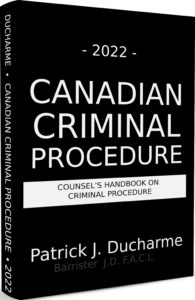 |
| Patrick Ducharme |
The issue of statements/confessions given to persons in authority during detention or arrest our courts will now look to the principles outlined in Oickle9 and Singh10 and Sinclair11 to determine whether there has been a Charter breach. In Oickle the Supreme Court of Canada examined in detail the common-law confessions rule. In so doing the court drew a sharp distinction between applications that allege a Charter breach and those that rely upon the common law rule. The court also concluded that the Charter does not subsume the common-law rule. Each is distinct for several reasons.
The confessions rule is broader in scope than the issues dealt with under the Charter. For example, the protections afforded by section 10 of the Charter apply only upon arrest or detention whereas the confessions rule applies whenever a person in authority questions a suspect. Under the Charter a different burden in the standard of proof is applicable. Under the Charter the onus of proof is usually upon the applicant on “the balance of probabilities”, whereas under the common law voluntariness rule, the burden is upon the prosecution to show beyond a reasonable doubt that a confession is voluntary. The remedies are different. The Charter excludes evidence obtained in violation of its provisions under subsection 24(2) only if admission of the evidence will bring the administration of justice into disrepute, whereas a violation of the confessions rule always warrants exclusion of the evidence.
In Singh the court reviewed the confessions rule and how it relates to the right to silence under the Charter. The court rejected an argument that the Charter subsumed the confessions rule. Prior to this decision, however, it was not apparent that the right to silence with respect to a statement made to a person in authority had been effectively subsumed in the common law voluntariness rule.
The trial Judge had found that the right to silence was a Charter issue only and therefore placed the burden upon the accused to prove a breach of a Charter right on a balance of probabilities. The Singh case decided that where the right to silence is an issue the Crown has the burden of proof, and, must prove beyond a reasonable doubt that it has not been breached. Charron J. outlined the differences nicely as follows:
Voluntariness, as it is understood today, requires that the courts scrutinize whether the accused was denied his or her right to silence. The right to silence is defined in accordance with constitutional principles, generally pursuant to section 7 of the Charter. A finding of voluntariness would normally be determinative of the section 7 issue.
Therefore, if the Crown proves the voluntariness of a statement made by the accused who is under arrest or in detention, beyond a reasonable doubt, there can be no finding of a Charter violation of the right to silence in respect of the same statement.
The converse holds true as well. If the circumstances are such that an accused is able to show on a balance of probabilities a breach of his or her right to silence, the Crown will not be in a position to meet the voluntariness test. It is important to understand, however, the proper scope of the constitutional right to silence, a question that I will address in a moment. Mr. Singh’s real dispute would be decided by determining the scope of the right to silence now constitutionally entrenched under section 7 of the Charter…

The above is the an excerpt of Patrick J Ducharme's book, Canadian Criminal Procedure, available at Amazon or in bulk through MedicaLegal Publishing along with Criminal Trial Strategies.
Subscribe to Patrick Ducharme's Youtube Channel
